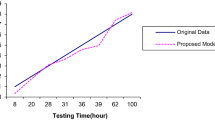33.7 Conclusion
This chapter presents a non-homogeneous Poisson progress reliability model for N-version programming systems. We separate all faults within NVP systems into independent faults and common faults, and model each type of failure as NHPP. We further develop a reliability model for common failures in NVP systems and also present a model for concurrent independent failures in NVP systems. By combining the CF model and the CIF model together, we establish an NHPP reliability model for NVP systems. We also give an example to illustrate how to estimate all unknown parameters by using the maximum likelihood estimation method, and how to compute the variances for all parameter estimates in order to obtain the confidence intervals of NVP system reliability prediction.
Access this chapter
Tax calculation will be finalised at checkout
Purchases are for personal use only
Preview
Unable to display preview. Download preview PDF.
Similar content being viewed by others
References
Voas J, Dugan JB, Hatton L, Kanoun K, Laprie J-C, Vouk MA. Fault tolerance roundtable. IEEE Software 2001;Jul/Aug:54–7.
Chen L, Avizienis A. N-version programming: a fault tolerance approach to the reliable software. Proc 8th Int Symp Fault-Tolerant Computing, Toulouse, France; 1978. p.3–9.
Avizienis A, Chen L. On the implementation of N-version programming for software fault-tolerance during program execution. Proc COMPASAC 77; 1977. p.149–55.
Eckhardt D, Lee L. A theoretical basis for the analysis of multiversion software subject to coincident errors. IEEE Trans Software Eng 1985;SE-11(12):1511–7.
Scott RK, Gault JW, McAllister DF. Fault-tolerant reliability modeling. IEEE Trans Software Eng 1987;SE-13(5):582–92.
Littlewood B, Miller DR. Conceptual modeling of coincident failures in multiversion software. IEEE Trans Software Eng 1989;15(12):1596–614.
McAllister DF, Sun CE, Vouk MA. Reliability of voting in fault-tolerant software systems for small output spaces. IEEE Trans Reliab 1990;39(5):524–34.
Leung Y-W. Maximum likelihood voting for fault-tolerant software with finite output-space. IEEE Trans Reliab 1995;44(3):419–26.
Randell B. System structure for software fault tolerance. IEEE Trans Software Eng 1975;SE-1(2):220–32.
Fairley R. Software engineering concepts. McGraw-Hill: New York; 1985.
Belli F, Jedrzejowicz P. Fault-tolerant programs and their reliability. IEEE Trans Reliab 1990;29(2):184–92.
Nicola VF, Goyal A. Modeling of correlated failures and community error recovery in multiversion software. IEEE Trans Software Eng 1990;16(3):350–9.
Lyu MR. Improving the N-version programming process through the evolution of a design paradigm. IEEE Trans Reliab 1993;42(2):179–89.
Knight JC, Leveson NG. An experimental evaluation of the assumption of independence in multiversion programming. IEEE Trans Software Eng 1986;SE-12.
Scott RK, Gault JW, McAllister DF, Wiggs J. Experimental validation of six fault tolerant software reliability models. Dig papers FTCS-14: 14th Ann Symp Fault-Tolerant Computing, Kissemmee, NY; 1984. p.102–7.
Eckhardt DE, Caglayan AK, Knight JC, Lee LD, McAllister DF, Vouk MA, Kelly JPJ. An experimental evaluation of software redundancy as a strategy for improving reliability. IEEE Trans Software Eng 1991;17(7):692–702.
Voas J, Ghosh A, Charron F, Kassab L. Reducing uncertainty about common-mode failures. In: Proc Int Symp on Software Reliability Engineering, ISSRE; 1997. p.308–19.
Laprie J-C, Arlat J, Beounes C, Kanoun K. Definition and analysis of hardware and software fault-tolerant architectures. IEEE Comput 1990;23(7):39–51.
Dugan JB, Lyu MR. System reliability analysis of an N-version programming application. IEEE Trans Reliab 1994;43(4):513–9.
Tai AT, Meyer JF, Aviziems A. Performability enhancement of fault-tolerant software. IEEE Trans Reliab 1993;42(2):227–37.
Goseva-Popstojanova K, Grnarov A. Performability modeling of N-version programming technique. In: Proc 6th IEEE Int Symp on Software Reliability Engineering (ISSRE’95), Toulouse, France.
Lin H-H, Chen K-H. Nonhomogeneous Poisson process software-debugging models with linear dependence. IEEE Trans Reliab 1993;42(4):613–7.
Kanoun K, Kaaniche M, Beounes C, Laprie J-C, Arlat J. Reliability growth of fault-tolerant software. IEEE Trans Reliab 1993;42(2):205–18.
Sha L. Using simplicity to control complexity. IEEE Software 2001;Jul/Aug:20–8.
Zhang X, Teng X, Pham H. A generalized software reliability model with error removal efficiency. IEEE Trans Syst, Man Cybernet 2002:submitted.
Pham H. Software reliability. Springer-Verlag; 2000.
Goel AL, Okumoto K. Time-dependent error-detection rate model for software and other performance measures. IEEE Trans Reliab1979;28:206–11.
Pham H, Nordmann L, Zhang X. A general imperfect-software-debugging model with s-shaped fault-detection rate. IEEE Trans Reliab 1999;48(2):168–75.
Pham H, Zhang X. An NHPP software reliability model and its comparison. Int J Reliab, Qual Safety Eng 1997;4(3):269–82.
Teng X, Pham H. A software reliability growth model for N-version programming. IEEE Trans Reliab 2002;51(3):in press.
Pham H, Pham M. Software reliability models for critical applications. INEL, EG&G-2663; 1991.
Editor information
Editors and Affiliations
Rights and permissions
Copyright information
© 2003 Springer-Verlag London Limited
About this chapter
Cite this chapter
Teng, X., Pham, H. (2003). Software Fault Tolerance. In: Pham, H. (eds) Handbook of Reliability Engineering. Springer, London. https://doi.org/10.1007/1-85233-841-5_33
Download citation
DOI: https://doi.org/10.1007/1-85233-841-5_33
Publisher Name: Springer, London
Print ISBN: 978-1-85233-453-6
Online ISBN: 978-1-85233-841-1
eBook Packages: Springer Book Archive




